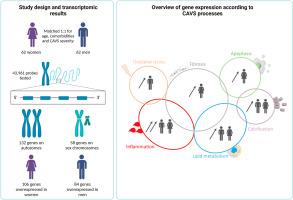三尖瓣主动脉瓣钙化性主动脉瓣狭窄患者性别差异的转录组学研究
IF 2.5
Q2 CARDIAC & CARDIOVASCULAR SYSTEMS
引用次数: 0
摘要
背景:钙化性主动脉瓣狭窄的瓣膜病变具有性别特异性:女性患者的严重程度与男性患者相似,但瓣膜钙化较少,瓣膜纤维化较多。因此,我们的目的是根据患者的性别来评估狭窄主动脉瓣的转录组。方法收集300个瓣膜,其中240个用芯片技术进行全基因组基因表达定量分析。其中62例女性患者与62例男性患者进行年龄(2岁以内)、体重指数(2 kg/m2以内)、动脉压(10/ 5mmhg以内)、糖尿病(精确)、高血压(精确)、钙化性主动脉瓣狭窄严重程度匹配。在剩余的60个瓣膜中,16名女性和16名男性患者相似匹配,进行实时定量聚合酶链反应分析。结果除了冠状动脉疾病的发病率和体表面积(男性患者较大)外,男女患者的临床和超声心动图特征具有可比性。共有190个基因在女性和男性患者中有不同的调控,其中132个在常染色体上,58个在性染色体上。在炎症和脂质代谢相关基因中发现了差异。与强化纤维化过程相关的基因(如tgf - β2、KIF1A、FRAS1)在女性与男性患者中过表达。与钙化增加相关的基因在男性(camd8、STC2)和女性(RCN2、TPD52L1)患者中均过表达。参与细胞凋亡的基因(CES4, SFRP4, TGFB2)在女性和男性患者中过表达。只有KIF1A通过实时定量聚合酶链反应分析得到验证。结论性别可能通过不同的机制影响女性和男性的主动脉瓣基因表达。本文章由计算机程序翻译,如有差异,请以英文原文为准。

A Transcriptomic Approach to Sex Differences in Calcific Aortic Valve Stenosis in Patients with a Tricuspid Aortic Valve
Background
Valvular lesions in calcific aortic valve stenosis are sex-specific: female patients reach a similar level of severity as male patients but with less valvular calcification and more valvular fibrosis. We thus aim to assess the transcriptome of stenotic aortic valves according to patients’ sex.
Methods
A total of 300 valves were collected, and genomewide gene expression was quantified using a microarray on 240. Among these, 62 female patients were matched with 62 male patients, for age (within 2 years), body mass index (within 2 kg/m2), arterial pressure (within 10/5 mm Hg), diabetes (exact), hypertension (exact), and calcific aortic valve stenosis severity. Among the 60 remaining valves, 16 female and 16 male patients were similarly matched for real-time quantitative polymerase chain reaction analysis.
Results
Clinical and echocardiographic characteristics of the patients were comparable between female and male patients, except for the incidence of coronary artery disease and body surface area (greater in male patients). A total of 190 genes were regulated differently in female vs male patients—132 on autosomes, and 58 on sexual chromosomes. Differences were found in inflammation and lipid metabolism–associated genes. Genes linked to intensified fibrosis processes (eg, TGFβ2, KIF1A, FRAS1) were overexpressed in female vs male patients. Genes associated with increased calcification were overexpressed in both male (CPAMD8, STC2) and female (RCN2, TPD52L1) patients. Genes involved in apoptosis (CES4, SFRP4, TGFB2) were overexpressed in female vs male patients. Only KIF1A was validated by real-time quantitative polymerase chain reaction analyses.
Conclusions
This study provides evidence that sex may influence aortic valve gene expression through different mechanisms in female vs male individuals.
求助全文
通过发布文献求助,成功后即可免费获取论文全文。
去求助
来源期刊

CJC Open
Medicine-Cardiology and Cardiovascular Medicine
CiteScore
3.30
自引率
0.00%
发文量
143
审稿时长
60 days
 求助内容:
求助内容: 应助结果提醒方式:
应助结果提醒方式:


